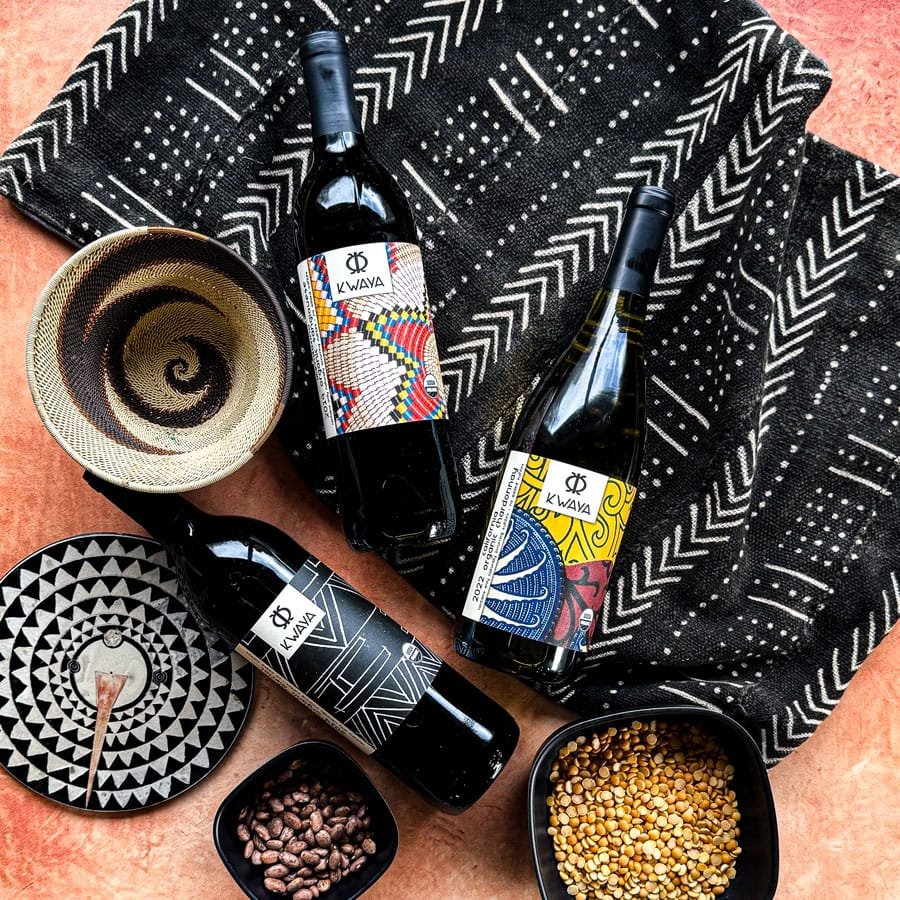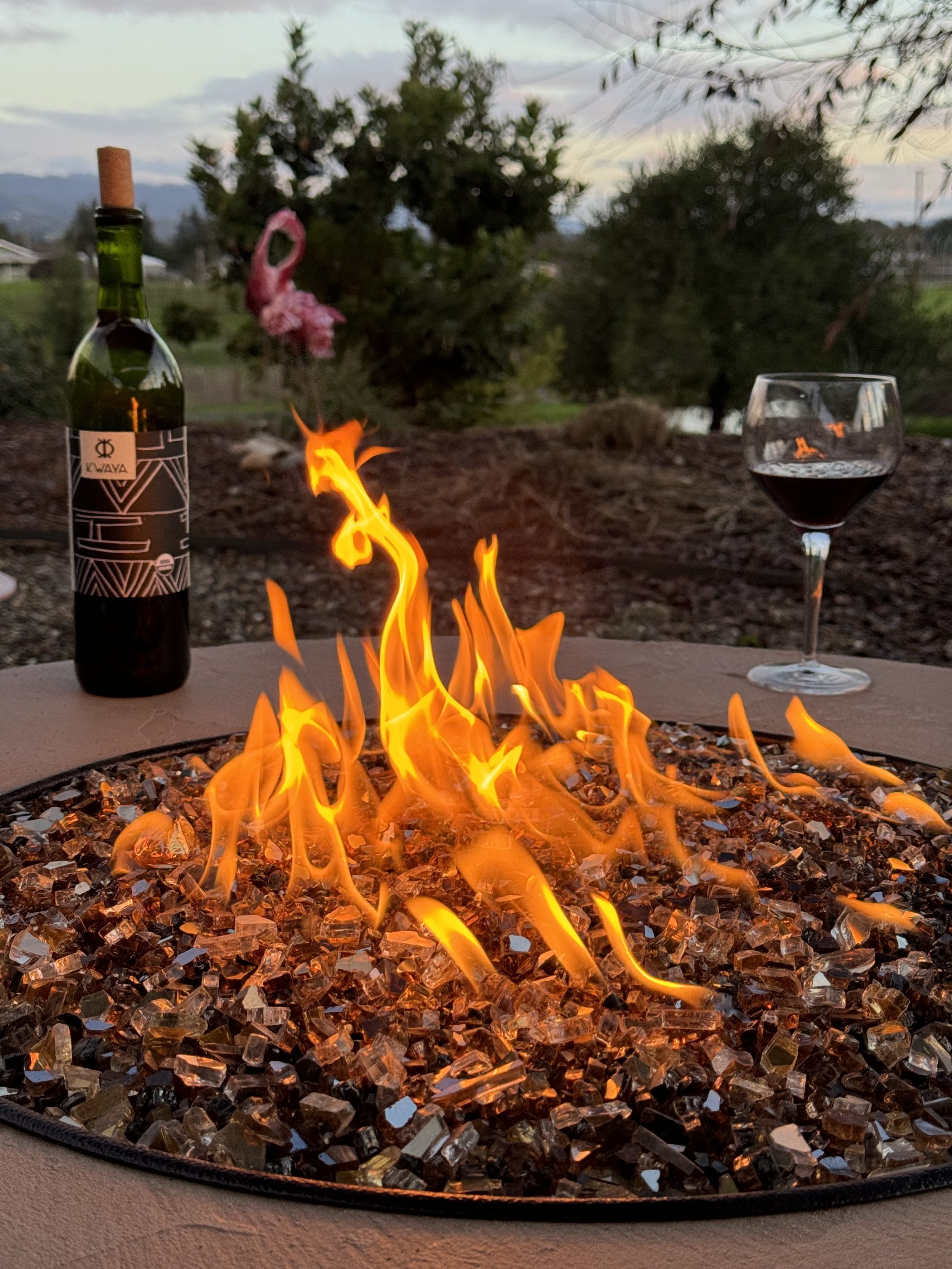February Wines of the Month Recipes
Kwaya Cellars organic wine selections
We are excited to share our February wines of the month recipes! In honor of Kwaya Cellars Organic wines and Black History Month, we decided to feature all three of the Kwaya varietals for our Wine of the Month Dinner. In keeping with the African-inspired cuisine, we showcased a delicious meal, paired with the Kwaya organic Merlot, Sangiovese, and Chardonnay. Frey Vineyards is the proud producer of Kwaya Cellars Organic Wines.
The “Kwaya” logo is an Adinkra symbol meaning “seed” and “perseverance”
For the February Wines of the Month recipes, we gathered at a private home in Redwood Valley to enjoy a clear, cool Winter evening. We shared stories near a fire while the Kwaya wines flowed freely.
The February Wines of the Month Recipes feature Californian takes on traditional African and African-American dishes. For the main dish, we prepared a fresh goat stew. We usually feature a local farmer who helped bring together the ingredients for the dinner. For the February Wine of the Month recipes, we showcased a goat ham that came from our Tomki Ranch neighbors. The goats were raised on the Frey ranch, and foraged between the vineyard rows during their lifetimes.
In African, goat stew is usually a melange of nightshades that have been cooked (and blended together) so that one can use the stew as a kind of dip for grain-based classics like “fufu” (fermented cassava). Using a California fusion style, we left the stewed vegetables whole in our stew. For our dinner menu, we prepared a Jollof rice and a cornbread to accompany the stew. We had a side of collard greens for good measure too!
Plated African-inspired dinner
Perhaps our February Wines of the Month recipes should begin with the collard greens. This recipe was inspired by tradition Southern versions of “Collard Greens” here in the states. On very low heat for a very long time, the collards simmered down in a fresh chicken broth.
Collards are a fresh, excellent vegetable to showcase in the Winter. To honor this veggie at the height of its seasonal glory, we decided to leave the stems in. Cass Tanning, our Wholesale Coordinator at Frey Vineyards, who hosted our February dinner party at her home, prepared the greens.
First, thoroughly wash your collards
Cook a large pack of bacon, cut up into small pieces
Use your bacon fat to sauté the onions (2 onions chopped finely) and garlic (a half dozen cloves chopped finely) until translucent
You can add up to a pound of smoked ham at this stage, cut into bit sized pieces. Cook until the ham has been coated by the bacon and alliums seasonings
Add your washed 2-3 lbs of collard leaves (you can take the leaves off the stem if you like or leave them in —since they cook for a long time, they will soften)
Cover everything with an ample amount of broth (10-12 cups of broth should do it)
Add a bit of salt & pepper to taste
Add a glug of apple cider vinegar (for a tangy bite) to your simmer pot
You can add a spoonful of sugar or maple syrup if you want for a bit of sweetness
Simmer on low for about 2 hours or until the greens are to your desired tenderness
Reserve the leftover liquid (for a soup base or another meal plan)
Enjoy this delicious classic!
Collard greens cooking
There are ample Jollof Rice and cornbread recipes on the web and handed down from family to family that will support you in preparing delicious versions of those dishes. We picked a few from our own web searches to create delicious side dishes for our February dinner.
Main Dish: Goat Stew
For the goat stew, I (Molly) prepared my crock pot with a goat “ham.” I cleaned off the ham, and added it to my crock pot to slowly cook, covered in water, a few cups of the Kwaya Merlot to add depth to the broth, and bouillon to taste for several hours. Once the goat had been cooked enough to fall off the bone, I took the goat meat out. Then, I added in the following to my rich bone broth while the goat cooled.
1-2 onions, finely chopped
4-6 cloves garlic, finely chopped
1-2 cup(s) diced carrots
3 large diced sweet potatoes
2 large diced red potatoes
2 cups diced tomatoes (fresh or canned)
1 can tomato sauce
2-3 chopped red bell peppers
1-2 spicy peppers as desired for heat or cayenne powder to taste
Spices: I used a mixture of thyme, curry powder, salt, and pepper.
With my ingredients in the stew pot, I carefully extracted the meat from the bone. I gently tore it into smaller pieces for a more enjoyable stew spoonful size, and then I added it back to the stew pot to mingle with all the other flavors for another 1-2 hours. Goat meat may need a lot of cooking time to be tender —when you remove your meat from the stew pot, check on the tenderness to make sure that it is already soft enough to eat. A bit more cooking will meld the flavors together so that everything melts in your mouth when the other ingredients have softened.
Alternatively, if you are going for a more authentic West-African-style goat stew, you can blend the ingredients (minus the goat meat) together (after sautéing them) and then add them into the stew pot until they cook into a thick sauce.
Tasting Notes
The following tasting notes on the Kwaya selections were provided by our Sensory technician, Éva-Marie Lind, who helps prepare several of the wine blends featured at Frey Vineyards. These are from the current vintages available for each of the Kwaya wines.
Chardonnay 2022 (fabulous grow season)
Key: orchard fruits + new spring florals, citrus custard, blanched almonds, sweet spice.
Nose — warming custard, *beurre d’anjou pear, the bloom of fig with a slight musk that arrives when hawthorne flowers bloom at a distance, meyer lemon
Palate — opulent bright fruit, lovely contrast to soft floral innuendo, momentary tart brightness (inference between flint and saline) a blush of Sicilian lemon, guava with a kiwi starfruit fringe, floral grass of palmarosa, flowering clove (eugenol), folding round, buttery, blanched almond and slight banana..
Creamy, lilting bright acidity
Eye: Imperial topaz – palest yellow, hints of pink
… a chameleon diaspora (truly multi-sensory)
Flavor combination: Grilled white fish (encrusted with piment d’ville), green veges (asparagus spears) and flowering broom + mimosa branches in a vase.
Sangiovese 2019
Key: mingled cherry to dark berry, currant tomato, caper, sweet spice and leather, saline uplift.
Nose — blackberry, plum, carnation, hint of coffee, tad of caramel
palate — (bitter) (dried) cherry, mulberry, currant and heart note of mid-season peony, bright tart pomelo, plum, crushed wild-currant tomato leaf, caper, earthy dry cinnamon with a tight tannic finish, sweet marjoram, licorice, pink peppercorn, aged black tea, dried lees and a hint of leather with a aftersplash of minerality
Bold white, juicy yet unfolding dry (even the nose has a wonderful dryness), medium acidity, finely tuned tannic structure
Eye: Ruby
Flavor combination: SO good with the filo-pastry wrapped cherry topped baked brie we had at FOPM, seeded crackers … flowering rosemary in a vase.
Merlot 2019
Key: violets + borage, black cherry, currant + rhubarb, earthy, caramel and balsamic whiskey refrain, edged by fennel, pine
Nose — velvety violets, sun-warmed black cherry, hint of blueberry and borage
Palate — (full body, plump) supple with earthy dry out, hinting of humus and slight dried tobacco, blackcurrant swirled with rhubarb, (silky) molasses and mahogany underpining, hint of angelica, mid-palate fig with ever so slight luminosity of opoponax (a tree gum resin with hints of whisky and browned caramel, slightly powdery carob, hint of fennel, sweet pine.
Soft plum, earthy, enveloping yet lean, balanced, structured tannin and nice acidity, lingering, enduring.
Eye: Garnet
Flavor combination: Medley of lentils, butternut squash and shaved dry cheddar (whiskey infused a bonus), Calendula blooms in a vase.
For a glimpse at our February wines of the month recipes at our dinner party…
Thanks for stopping by to check out our February Wines of the Month recipes. As you can see, we had a great time sharing this delicious meal with colleagues and friends. The Kwaya wines paired beautifully with our dinner, we had a cozy evening snuggling dogs, and we shared stories as we enjoyed ourselves in the heart of Mendocino County. Join us again next month for more recipes!
The Kwaya Wines










